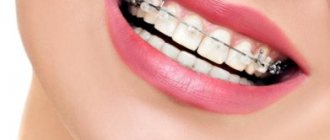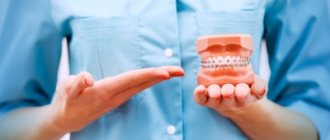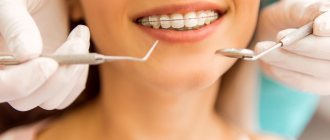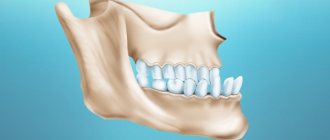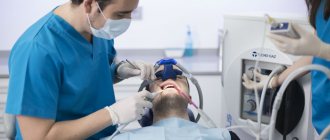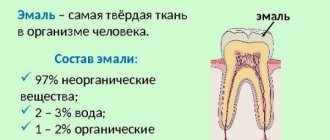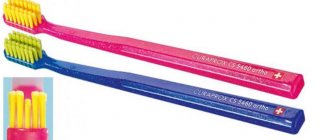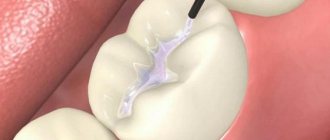Dentistry has long been no longer limited to primitive dental treatment. Today, it offers many specialized services that satisfy all kinds of patient needs. There are dental therapists, dental surgeons, orthodontists and orthopedic dentists. It is worth taking a closer look at the specialization of an orthopedic dentist and finding out what exactly he does in his practice.
Competence of an orthopedic dentist
An orthopedic dentist deals with dental prosthetics and its renewal and restoration. These concepts differ, since it is possible to renew the surface of a tooth with healthy roots, but with root diseases, teeth need to be prosthetized or implanted. In addition to restoring the aesthetic appearance of the smile and restoring minor defects in the dentition, the orthopedic dentist also restores the most important dental functions, primarily chewing.
Content:
- Competence of an orthopedic dentist
- Symptoms and diseases
- Types of diagnosis and treatment
- Types of orthopedics in dentistry
- Preparing for the visit
- How to choose an orthopedic dentist
The specializations of an orthopedic dentist are removable prosthetic methods, fixed and conditionally removable types of dental restoration.
He is also engaged in making impressions for the subsequent production of all necessary structures by dental technicians - crowns, inlays, etc.
That is why dental orthopedics is one of the most popular specializations today. Very often, children have recently become patients of orthopedic dentists.
At the first consultation, the doctor determines the presence of damage to the patient’s masticatory apparatus and its extent.
After the diagnosis is made, a special treatment plan is drawn up, which necessarily includes preparing the oral cavity for restoration of the dentition or prosthetics, as well as the necessary orthopedic measures, the choice of the type of prosthetics or renewal of the design of the existing prosthesis, and, if necessary, the installation of dentures.
Before starting treatment, the necessary examination and preparation of the patient is carried out, including an orthopantomogram, tomography, wax modeling and other highly specialized examinations. All responsibility for choosing the material and making the best prosthesis in each case also falls on the orthopedic dentist.
What is the difference?
What is the difference between an orthopedic dentist and an orthodontist, read below.
Firstly, the activities of doctors are aimed at correcting various defects . An orthodontist works with dental anomalies, he straightens teeth and improves chewing function. An orthopedist specializes in restoring decaying teeth and installing implants.
If you evaluate Internet queries, it becomes clear that people do not always understand which doctor they need to see - an orthodontist or an orthopedist.
It is worth remembering that orthodontists are found only in dentistry. At the same time, orthopedics is a broader concept, so such a doctor can work not only in a dental clinic. There are orthopedists who deal with problems with the musculoskeletal system.
Symptoms and diseases
An orthopedic dentist, in addition to prosthetics, treats various diseases of the oral cavity.
Such diseases include: caries, chipped teeth, periodontitis, pulpitis, cracks in tooth tissue, tooth erosion, chyleitis.
If any of these symptoms are present, a mandatory consultation with a good orthopedic dentist is required:
- tooth pain when biting hard foods;
- pain during daily brushing of the teeth;
- the occurrence of tooth sensitivity;
- the occurrence of bleeding gums;
- redness and swelling of the gums;
- night pain in carious areas or places under crowns;
- destruction of interdental septa;
- the occurrence of tartar.
The importance of aesthetics and function
When replacing anterior teeth, the main requirement for the design is its appearance, so for restoration in the smile area, ceramic veneers or crowns would be the ideal choice. In terms of its properties, this material is as close as possible to natural tooth enamel and has natural transparency. And for the lateral areas, where the strength of the structure and its ability to withstand heavy chewing loads are more important, dentures made of metal-ceramics or zirconium dioxide would be a suitable solution.
Publisher: Expert magazine about dentistry Startsmile.ru
Types of diagnosis and treatment
Consultation and treatment with an orthopedic dentist may be necessary for a variety of dental problems. This specialist provides diagnosis and treatment in the following areas:
- diagnostic examination of dental units and bone tissue condition;
- identification of destruction of jaw bones and dental tissues;
- restoration of the functional load of teeth by installing dentures;
- installation of artificial devices (implants) that can replace fangs, incisors and molars in the dentition.
It is important to remember that all dental specialists often work in a complex manner, that is, when contacting an orthopedic dentist, you need to be prepared to visit a general dentist, an orthodontist and a surgeon.
Only a comprehensive examination and treatment will help ensure the longevity of prostheses and implants, as well as the rapid survival of the latter.
The most common situations are when a dental therapist refers a patient to an orthopedist after he diagnoses diseases or problems associated with this type of activity at his own appointment. If there is a need to clarify the details of problems with the dentition, the orthopedist can refer the patient for additional examinations:
- orthopantomogram (shows a panoramic image of the jaws);
- computed tomography;
- digital dental x-ray diagnostics;
- wax modeling of jaws;
- axiography;
- diagnostic jaw models.
Sometimes a simple x-ray is enough, after which the entire subsequent picture of treatment becomes clear. At the next stage, the doctor identifies temporary or permanent contraindications to the use of drugs and, taking this into account, makes impressions, which are then sent to the laboratory to dental technicians. When the products are ready, they are adjusted to the patient, implants, bridges, etc. are installed. After this, the orthopedist prescribes a schedule for further visits, warns the patient about the rules for caring for prostheses and the side effects that arise during the process of getting used to them. It becomes necessary to visit a doctor regularly in order to ensure full functionality of the dentition and prevent the emergence of new problems.
If ulcers, swelling, inflammation of the gum tissue and redness occur while wearing dentures or implants, you should consult a doctor immediately. Many defects of dentures are not visible immediately after their installation; they begin to appear only while the denture is worn, which is why the doctor in the clinic will not always be able to foresee all the problems with a particular patient. But if you seek help in a timely manner after detecting defects, there is a high chance that the doctor will easily eliminate them, and the crown or bridge can then be worn with a high degree of comfort.
Who does prosthetics and dental implants?
If you are interested in which doctor places dental crowns, then know that this is done by an orthopedist - a doctor of narrow specialization who can combine his function with another dental specialty. Often, a prosthetist combines practice with surgical activities, since the installation of many prostheses requires surgical intervention.
The services of an orthopedic surgeon are in demand to implant an artificial root into the bone, install an abutment and fix a crown on it. Implantation is a serious intervention that requires a comprehensive diagnosis of the mouth. Based on the results, the specialist develops a prosthetic plan and makes impressions for the crown.
Types of orthopedics in dentistry
Among the main areas that an orthopedic dentist deals with are implantation, removable, fixed and conditionally removable prosthetics.
Implantation is a procedure for restoring the aesthetics of the dentition. The high cost of materials and a large number of contraindications and restrictions for the implementation of implants do not stop patients from dreaming of getting a new full-fledged tooth, and not inserts or bridges.
The essence of the implantation method is that in a place where a tooth is missing, an orthopedic dentist implants a titanium pin into the bone tissue. After the pin has taken root, the doctor places an abutment or a base for a future crown on its rod part.
High-quality dental implants can serve their owners for more than 30 years, firmly held in the bone and without causing any inconvenience to the person.
With removable prosthetics, the patient in the future independently cares for the structure and sometimes removes it. Removable dentures are made of acrylic, nylon or plate. Such designs are relatively cheap, provide good chewing functions, are durable and can qualitatively improve the appearance of the dentition. Some types of removable dentures solve the problem of complete loss of teeth in the upper or lower jaws.
Fixed prosthetics have a more complex technique, but the results are worth it. However, with fixed prosthetics, it is important to take into account one nuance - the teeth adjacent to the prosthetic often have to be ground down, which subsequently leads to the loss of healthy teeth in the neighborhood. In addition, such a prosthesis can be installed only if there are absolutely healthy teeth next to the object of prosthetics, since they will serve as a support for bridges, crowns or inlays. Thus, the orthopedic dentist is able to restore the damaged part of the tooth without resorting to implantation or prosthetics, in cases where it is impossible to restore the tooth with a filling.
A crown can be used to restore, basically, a pulpless tooth that has previously been deprived of nerves. They are made from various materials. Today, the most common are metal-ceramic crowns, which have a metal frame and are covered with ceramics on top.
Inlays are used in cases where the crown part of the tooth is preserved in some places, and material can be inserted into the existing cavity to hide the defect. The technique of tooth restoration using inlays is called microprosthetics. The finished liner is attached to the tooth by introducing filling material.
Veneers are thin plates that are attached to the front surface of the tooth. They are mainly used to restore the surface of the front teeth, allowing these teeth to acquire a natural appearance and color. Veneers are made from porcelain or ceramics. The cost of fixed dentures varies depending on the materials for making artificial teeth and fastening elements. Such structures last for about 10 years if you care for them competently and efficiently.
With conditionally removable prosthetics, only the doctor is able to quickly and painlessly remove a molar or canine from the dentition, and the patient himself will not be able to do this. This technique is used to restore one unit in the dentition.
When should you contact an orthodontist?
First of all, children need to consult a doctor. It is better to schedule the first visit to coincide with the 2nd or 3rd birthday, and repeat the next visit at the age of five, when baby teeth begin to change to permanent ones. It is also necessary to visit a doctor if the teeth are not growing properly, as well as if the child has bad habits or congenital anomalies. Timely treatment will prevent severe correction in older age.
Other reasons to visit an orthodontist include:
- Improper closing of the jaws.
- Premature loss of baby teeth.
- Impaired diction.
After the diagnosis is made, the doctor will select the optimal treatment method and send the patient for preparation. Before the orthodontist begins his work, caries and plaque must be removed.
Today, there are many models of braces that will not spoil a person’s appearance.
For example, on some products the plates are positioned so that they can be easily attached to the back of the teeth. There are also ceramic braces that become almost invisible due to the fact that they blend with the shade of tooth enamel.
Here are a few methods that orthodontists use in their work.
- Myotherapy . This is the most gentle method and is most often used when working with children. It is a kind of gymnastics that helps the bite and jaw form correctly. It is used only during the period of growth of the dentofacial apparatus.
- Hardware method involves the use of braces, aligners, plates. Suitable for both adults and teenagers. To eliminate dental defects, you will have to be patient, because the process is quite long and consists of two stages.
- First, the doctor needs to fix the problem, for example, prescribe a course of treatment with orthodontic devices. This stage can last from six months to several years. The entire period of treatment should be shown to the orthodontist for monitoring and adjustment if necessary.
- After achieving results, a retention stage follows to consolidate the effect obtained. When an orthodontic structure is removed from the mouth, a retention device is placed in its place - a thin wire that holds the teeth together on the back side. With such a design you will also have to walk for a certain time.
- The surgical method is used in extreme cases when other methods do not bring results. Usually prescribed for serious problems of the jaw system, as well as in the presence of crowded teeth. The orthodontist prepares the patient for the operation, and the dental surgeon performs it.
The bracket system is considered the most effective, but aligners are becoming increasingly popular today. These are transparent elements for each tooth, which, thanks to the material, remain completely invisible.
Preparing for the visit
An orthopedic dentist can conduct lengthy appointments, depending on the severity of the problem the patient is addressing, the ability to immediately detect defects and determine ways to eliminate them. In addition, often the orthopedist can send the patient for an x-ray during the examination, to a surgeon or therapist. Therefore, in order to feel optimal at an appointment with this doctor, you should prepare for such a visit.
An hour before visiting the doctor, you need to eat a hearty meal, but the food should not be fatty. It is not recommended to visit the dentist on an empty stomach, since hunger increases salivation, which can interfere with a normal examination.
You should absolutely not drink alcohol the day before visiting the dentist.
Before visiting a doctor, you should thoroughly clean your mouth of food debris and plaque. If you have dentures, you must bring them with you to your appointment.
It is important to make a list of all your chronic diseases in order to notify your doctor about them. Many types of prostheses have a number of contraindications that can lead to very serious consequences.
